Volcanoes
Steven Dutch, Professor Emeritus, Natural and Applied Sciences, University of Wisconsin - Green Bay
Bowen's Series and Igneous Rocks
| Mineral Composition | ||||
| Ca Plagioclase | Na Plagioclase | K - Feldspar | Muscovite | |
| Quartz | ||||
| Olivine | Pyroxene | Amphibole | Biotite | |
| Volcanic Rocks | ||||
| (Rare) | Basalt | Andesite |
Rhyolite |
|
| Plutonic Rocks | ||||
| Dunite | Gabbro | Diorite | Granite | |
| 1200 C | Melting Point | 700 C | ||
| Heavy | Density | Light | ||
| Mg, Fe | Rich In... | Si, Na, K | ||
| Fluid | Lava Is... | Viscous | ||
| Mild | Eruptions | Violent | ||
| Type of Volcano | ||||
| Shield Volcano | Stratovolcano |
Plug Dome |
||
| Rapid | Weathering | Slow | ||
| Usually Dark | Color | Often Light | ||
Types of Volcanoes
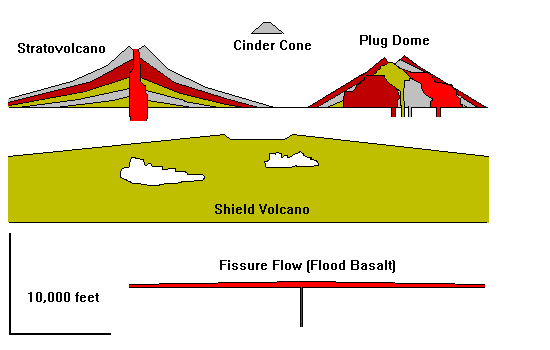
Products of Eruptions
- Lava Flows
- Pyroclastic Debris
- Bombs
- Lapilli
- Ash
- Mudflows
- Gases
- Steam
- Carbon Dioxide
- H2S
- SO2
- HCl
- HF
Environmental Hazards of Volcanoes
- Pollution
- SO2, HCl in Water
- Ash Falls
- Building Collapse
- Crop Destruction
- Mudflows
- Direct Damage (Colombia, 1985)
- Floods (Several Types)
- Lava Flows
- Falling Ejecta
- Blast (Mt. St. Helens, 1980)
- Nuee Ardente (St. Pierre, 1902)
- Gas (Lake Nyos, Cameroon, 1986)
Greatest Earthquakes and Volcanic Eruptions
Nuee Ardente (French: Fiery Cloud) or Pyroclastic Flow
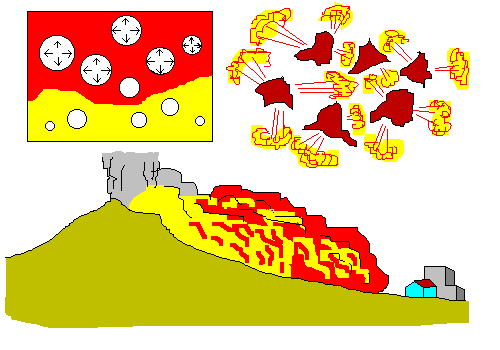
- Gas Expands as Lava Rises
- Lava Breaks up into Fragments Supported by Escaping Gas
- Cloud Flows Downhill at 60-100 M.p.h. Temperature about 1000 C
How Calderas Form
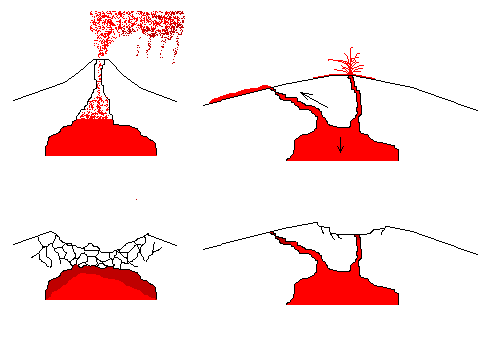
Calderas form when volcanoes collapse. In some cases, violent explosive eruptions (left) can empty a magma chamber enough that the summit collapses. In other cases, magma may erupt on the flanks of a volcano or drain back to deeper levels, permitting the summit to subside (right). These caldera collapses are generally not violent.
Evolution of Volcanoes
An active volcanic landscape
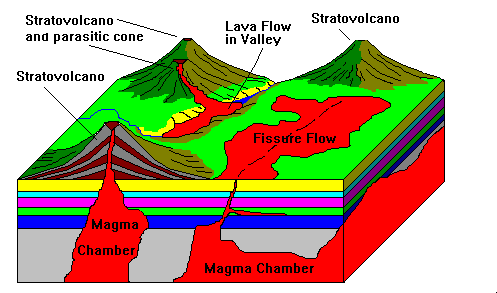
A volcanic landscape after a million years or so
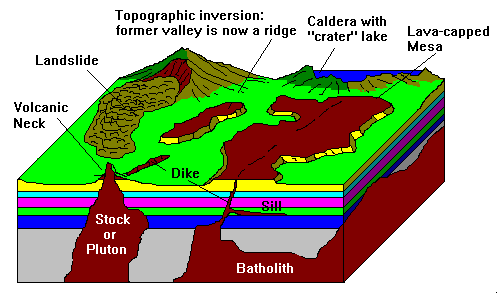
This figure shows some of the things that can happen to a volcanic area over time:
- Erosion of a volcano, leaving solidified magma in the conduit as a volcanic neck.
- Collapse of a volcano in a catastrophic landslide, now recognized as a common event in the lives of volcanoes.
- Collapse of a volcanic summit to form a caldera and perhaps a "crater" lake.
- Erosion to leave lava-capped hills as mesas, or former valley-filling flows as ridges.
Return to Earth Science Notes Index
Return to Physical Geology Notes Index
Return to Professor Dutch's home page
Created 3 September 2003, Last Update